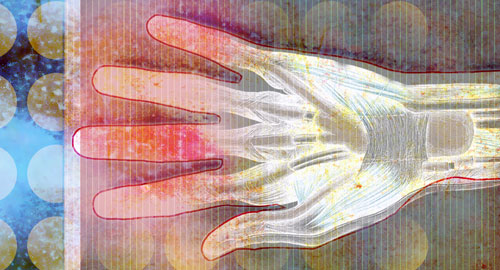 Patients with carpal tunnel syndrome (CTS) experience pain due to nerve entrapment. Often, the pain is bilateral, and patients also complain of increased pain sensitivity and widespread symptoms. This pain profile suggests a generalized disturbance of somatosensory function. Such a disturbance may be concerning, because previous studies have suggested pain sensitization in such conditions as knee and hip osteoarthritis, shoulder pain and elbow tendinopathy are associated with poorer clinical outcomes after surgery or conventional intervention.
Patients with carpal tunnel syndrome (CTS) experience pain due to nerve entrapment. Often, the pain is bilateral, and patients also complain of increased pain sensitivity and widespread symptoms. This pain profile suggests a generalized disturbance of somatosensory function. Such a disturbance may be concerning, because previous studies have suggested pain sensitization in such conditions as knee and hip osteoarthritis, shoulder pain and elbow tendinopathy are associated with poorer clinical outcomes after surgery or conventional intervention.
Young Hak Roh, MD, PhD, assistant professor in the Department of Orthopedic Surgery at the Ewha Womans University College of Medicine, South Korea, and colleagues investigated the role of centrally mediated symptoms on functional outcomes after carpal tunnel release surgery. The study included 120 mostly female patients with surgically treated CTS. Dr. Roh operated on all of the patients between January 2014 and October 2017, using the same technique. Patients returned for functional assessments at three months and one year. The researchers found that, although pain sensitization in CTS patients did correlate with preoperative symptom severity and duration, centrally mediated CTS symptoms did not have a persistent effect on functional outcomes after surgery. The results were published online July 24 in Scientific Reports.¹
The investigators measured centrally mediated symptoms by administering a self-reported central sensitization inventory (CSI) questionnaire. The questionnaire provided information about various centrally mediated symptoms, including 25 somatic and emotional symptoms. The team measured peripheral sensitization by assessing the patient’s pressure pain thresholds (PPT) in the forearm. This test identified the cut-off points at which a patient’s sense of pressure changed to pain. Finally, Dr. Roh and colleagues used the Boston Carpal Tunnel Questionnaire (BCTQ), both pre- and postoperatively, to assess symptom severity and function.
“Results of our study suggest pain sensitization measured by CSI and PPT that manifests at different degrees over a continuum correlates with preoperative symptom severity and duration,” write the authors in their discussion. “They were associated with poorer functional outcome scores after carpal tunnel release up to three months. However, they did not show persistent effects in the long term [at 12 months].”
Specifically, the researchers found preoperative centrally mediated symptoms were slightly correlated with higher BCTQ scores and moderately correlated with CTS symptom duration. In contrast, PPT only slightly correlated with BCTQ symptom and function scores.
As expected at three months after surgery, the investigators found BCTQ symptom and function scores showed significant clinical improvements relative to baseline BCTQ scores. Moreover, at three months post-surgery, the BCTQ symptom and function scores moderately correlated with lower PPTs and higher CSI scores.
When the researchers evaluated multiple potential confounding variables, including age, gender, body mass index, education, affected side, bilaterality, symptom duration, electrophysiological grade and baseline BCTQ scores, they found three factors—preoperative PPT, CSI and female gender—accounted for approximately one third of the variance in BCTQ scores at three months after surgery. However, these factors were not associated with 12-month outcomes. At 12 months, only severe electrophysiological grade was associated with higher BCTQ function scores.
Lara C. Pullen, PhD, is a medical writer based in the Chicago area.
Reference
- Roh YH, Kim S, Gong HS, et al. Influence of centrally mediated symptoms on functional outcomes after carpal tunnel release. Sci Rep. 2018 Jul 24;8(1):11134.


